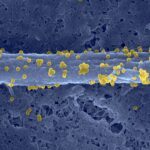Link to Pubmed [PMID] – 31251828
Link to DOI – 10.1111/1462-2920.14726
Environ Microbiol 2019 Dec; 21(12): 4478-4487
Advances in whole-genome sequencing (WGS) technologies have documented genetic diversity and epidemiology of the major foodborne pathogen Listeria monocytogenes (Lm) in Europe and North America, but data concerning South America are scarce. Here, we examined the population structure and genetic diversity of this major foodborne pathogen collected in Brazil. Based on core genome multilocus sequence typing (cgMLST), isolates from lineages I (n = 22; 63%) and II (n = 13; 37%) were distributed into 10 different sublineages (SLs) and represented 31 new cgMLST types (CTs). The most prevalent SLs were SL9 (n = 9; 26%), SL3 (n = 6; 17%) and SL2 and SL218 (n = 5; 14%). Isolates belonging to CTs L2-SL9-ST9-CT4420 and L1-SL315-ST520-CT4429 were collected 3 and 9 years apart, respectively, revealing long-term persistence of Lm in Brazil. Genetic elements associated with stress survival were present in 60% of isolates (57% SSI-1 and 3% SSI-2). Pathogenic islands were present in 100% (LIPI-1), 43% (LIPI-3) and 6% (LIPI-4) of the isolates. Mutations leading to premature stop codons were detected in the prfA and inlA virulence genes. This study is an important contribution to understanding the genomic diversity and epidemiology of Lm in South America. In addition, the results highlight the importance of using WGS to reveal Lm long-term persistence.

